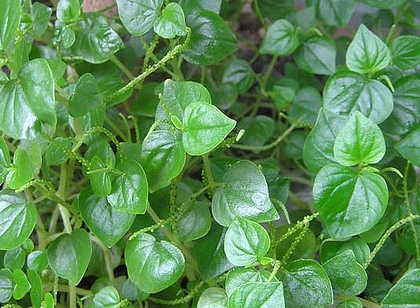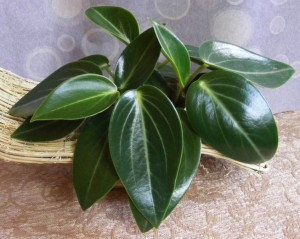
Snowy Corthell Hall, then at the University of Maine, where I spent most of my college years, photo by My View From Maine
I went to college in Maine where winter lasts from about November 1st to October 31st. I’m fond of telling people I love summer in Maine… both days of it. With the majority of the year cold and green plants scarce I made a lot of terrariums to have greenery around. I was always raiding Skillins Greenhouse in Falmouth for plants. (Nice to know some 40 years later — 2012 — they are still in business. Then again they opened doors in 1885.) And if you have never lived in snow you truly don’t realize how wondrous greenhouses are in the wintertime. Ten degrees outside and snow to your knees, warm and humid and earthy inside. Alive! Greenhouses were a source of joy and depression because they were beautiful and the promise of warm weather always months away.
A plant I used often in my terrariums for a tropical look and got at Skillins was Peperomia. I got the houseplant version and there’s about a thousand species in the genus, two of which are commonly eaten, Peperomia pellucida (Greenhouse Tea Plant, Shiny Bush) and Peperomia maculosa (Cilantro Peperomia… guess what it tastes like?) Most of the species are from the tropical Americas but 17 hail from Asia. Most have flower spikes similar to a Plantago but are more showy, think inverted catkin.
While the P. maculosa is used as a spice the P. pellucida is main fare for salads and as cooked greens. This Peperomia has a good nutritional profile. A 100 grams portion of P. pellucida has approximately 277 mg of potassium. It also has: 1.1 grams carbohydrates, 0.5 gram protein, 0.5 gram fat, 94 mg calcium, 13 mg phosphorous, 4.3 mg iron, 1250 mg beta carotene and 2 mg ascorbic acid. Its leaves have also been used to make tea. Besides food the Peperomia pellucidahas quite a medical legacy.Historically the plant has numerous ethnomedicinal uses as an anti-inflammatory and analgesic properties. Peperomia pellucida has shown antibacterial activity against Staphylococcus aureus, Bacillus subtilis, Pseudomonas aeruginosa, and Escherichia coli. It is approved by the Philippines’ Department of Health for various uses. One of them is a decoction used to decrease uric acid levels (as a remedy for rheumatism and gout) and to treat renal problems. Boil 1 ½ cups of the plant with 2 cups of water for 15-20 minutes.) It is also used topically for skin disorders such as acne and boils. See Herb Blurb below.
As for botanical name, Peperomia (pep-er-ROM-ee-ah) is two Greek words mashed together — “Pepper” and “Same” — read it means “like peppers.” Pellucida (pell-LOO-see-duh) is Dead Latin for small and translucent, a reference to the leaves. Maculosa (mack-
Green Deane’s ITEMIZED Plant Profile: Peperomia
IDENTIFICATION: Pereromia pellucida: Grows to one foot tall, stem initially erect, smooth, no hair, leaves fleshy and heart-shaped, smooth like candle wax, shiny light green, translucent, resemble pepper leaves but smaller. It has a very small bisexual flower growing from cord-like spikes from the leaf axils.Fruit as very small, round to oblong, ridged, green turning to black. One single seed with longitudinal ribs and ladder-like reticulation. The plant has a mustardy odor.
TIME OF YEAR: Year round in native habitat. Seasonal when temperatures are over 50/55 F. Can bloom all year but favors the spring.
ENVIRONMENT: It likes damp woods, coastal plains, niches in rocks, plant nurseries and greenhouses. Best cultivated in a light, well drained rich soil with plenty of humus. Does well in shallow containers, likes terrariums. Coming from tropical rain-forest habitats, it prefers warm, humid conditions and needs a minimum temperature of 50 – 55°F Besides it native range it can be found in Puerto Rico, the Virgin Islands, Alabama, Florida, Georgia, Louisiana, Texas (Houston area) and Hawaii; Mexico, West Indies, Central America, and South America. Peperomia maculosa is naturalized in Puerto Rico.
METHOD OF PREPARATION: P. pellucida: succulent leaves and shoots can be eaten in salads, used as a potherb, or cooked as greens. The leaves are also brewed into a tea. P. maculosa: The coriander-tasting leaves are used for seasoning usually with legumes and meats.
HERB BLURB
J Ethnopharmacol. 2004 Apr;91(2-3):215-8.: Anti-inflammatory and analgesic activity of Peperomia pellucida (L.) HBK (Piperaceae). de Fátima Arrigoni-Blank M, Dmitrieva EG, Franzotti EM, Antoniolli AR, Andrade MR, Marchioro M.
Source: Laboratório de Farmacologia, Departamento de Fisiologia/CCBS, Universidade Federal de Sergipe, Campus Universitário, São Cristóvão, SE CEP 49100-000, Brazil.
Abstract: An aqueous extract of the aerial part of Peperomia pellucida (L.) HBK (Piperaceae) was tested for anti-inflammatory (paw edema induced by carrageenin and arachidonic acid) and analgesic activity (abdominal writhes and hot plate) in rats and mice, respectively. Oral administration of 200 and 400 mg/kg of the aqueous extract exhibited an anti-inflammatory activity in the carrageenin test, which was based on interference with prostaglandin synthesis, as confirmed by the arachidonic acid test. In the abdominal writhing test induced by acetic acid, 400 mg/kg of the plant extract had the highest analgesic activity, whereas in the hot-plate test the best dose was 100 mg/kg. The LD(50) showed that Peperomia pellucida (5000 mg/kg) presented low toxicity.
PMID:
15120441
[PubMed – indexed for MEDLINE]
Introduction: Peperomia pellucida (Linn.) HBK (Fam. Piperaceae), locally known as Luchi Pata, is an annual herb (1) that is widely distributed in many South American and Asian countries (2-5). The plant is refrigerant; its leaves have been used traditionally in the treatment of headache, fever, eczema, abdominal pains, and convulsions (1). Evaluations of antibacterial, antiinflammatory, and analgesic activity of P. pellucida were reported in literature (2, 6-7). Isolation of antifungal and anticancer constituents from this plant was also reported (8-9). Although the leaves of the plant is used traditionally in the treatment of pyrexia and its antipyretic related activities (such as antiinflammatory and analgesic activity) were found experimentally, its antipyretic potential has not been explored yet. In the present study an attempt has
been made to establish the antipyretic effect of petroleum ether and ethyl acetate soluble fractions of ethanol extract of the leaves of Peperomia pellucida. Pyrexia or fever is caused as a secondary impact of infection, malignancy or other diseased states (10). It is the body’s natural function to create an environment where infectious agents or damaged tissues can not
survive (10). Normally the infected or damaged tissue initiates the enhanced formation of proinflammatory mediators (cytokines, such as interleukin 1?, ?, ?, and TNF- ?), which increase the synthesis of prostaglandin E2 (PgE2) near hypothalamic area and thereby trigger the hypothalamus to elevate the body temperature (11). When body temperature becomes high, the temperature regulatory system, which is governed by a nervous feedback mechanism, dilates the blood vessels and increases sweating to reduce the temperature. When the body temperature becomes low, hypothalamus protects the internal temperature by vasoconstriction. High fever often increases faster disease progression by increasing
tissue catabolism, dehydration, and existing complaints, as found in HIV (12). t
Turk J Biol
32 (2008) 37-41
© TÜB‹TAK
37
Antipyretic Activity of Peperomia pellucida Leaves in Rabbit
Alam KHAN, Moizur RAHMAN, Shariful ISLAM
Department of Pharmacy, University of Rajshahi, Rajshahi 6205, BANGLADESH
Department of Animal Husbandry and Veterinary Science, University of Rajshahi, Rajshahi 6205, BANGLADESH
Received: 08.05.2007
Abstract: Antipyretic effects of petroleum ether and ethyl acetate soluble fractions of ethanol extract of the leaves of Peperomia pellucida (Linn.) HBK (Fam. Piperaceae) were investigated. Intraperitoneal administration of boiled milk at a dose of 0.5 ml/kg body weight in albino rabbit leads to pyrexia. Intraperitoneal (i.p.) administration of petroleum ether and ethyl acetate soluble fractions of ethanol extract of the leaves of P. pellucida at a dose of 80 mg/kg body weight significantly reduced the elevated body temperature of rabbit. This antipyretic effect has been compared with antipyretic effect of standard aspirin and the solvent used . Peperomia pellucida (Linnaeus) Kunth, Nov. Gen. Sp. 1: 64. 1816.



![DSCN0097[1]](https://www.eattheweeds.com/wp-content/uploads/2017/09/DSCN00971-300x224.jpg)

